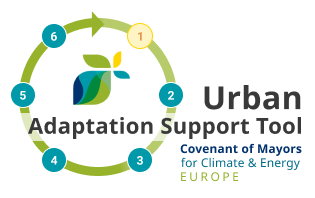
Preparing the ground for adaptation
1.3 Setting up adaptation processes within and beyond the municipality
Adaptation is a complex, cross-sectoral, multi-issue and multi-level decision-making area and as such requires a certain setup to ensure success, consistency and continuity. The setup should be tailored to the size and capacities of the municipality (e.g. some cities might create specific adaptation units while others mainstream adaptation into the work of existing departments). In either case, the best results are achieved through establishing a core team with an explicit mandate for the management of the process and liaising with all relevant administrative bodies, as well as identifying stakeholders to be involved in the adaptation process, including those from areas surrounding the city (see Step 2.5).
Establish a core team
To sustain an adaptation process in the long-term, a clear mandate for the management of the adaptation process should be given to an organisation, department or a smaller group of employees. The precise responsibilities of the core team might be context-specific but can range from steering the process within the public authority to formulating policy drafts, acting as a contact point for adaptation to communicating adaptation internally and externally. Members of the core team should ideally have long standing experiences with weather/climate-related issues and should be qualified to cover a broad range of topics that might be relevant for the adaptation process.
Guidelines for establishing a core adaptation team:
- Determine the members and obtain their consent;
- Define the tasks of the group at the first meeting;
- Agree upon the structure for collaboration (e.g. frequency of meetings, type of communication within the core team, rules of cooperation);
- Create a schedule and set milestones;
- Identify cooperation needs with other administrative bodies and stakeholders;
- Communicate, both internally (management) and externally (public, etc.) and with decision makers;
- Organise a transparent documentation of all steps taken in the process;
- Liaise with other relevant administrative bodies.
All relevant departments or authorities (e.g. responsible for health, civil protection, transport, energy, economy, finance, education, utilities, social services, etc. - see Step 1.6) need to be informed and involved in the adaptation process, receiving a clear mandate to take decisions in their fields of responsibility. This applies as well to the core team discussed above. Their degree of involvement may vary from providing and exchanging information to building adaptive capacity or taking decisions on adaptation within their sphere of authority.
It is also beneficial to make use of and coordinate with existing platforms and institutional setups. In particular national platforms for disaster risk reduction, which many European countries have established, provide a multi-sectoral platform that could facilitate interaction between disaster risk reduction and adaptation stakeholders.
Identify affected stakeholders and involve them in the adaptation process
Cooperation with relevant stakeholders, including interest groups, non-governmental organisations (NGOs) or those from the private sector, can be set up with different levels of involvement. The level of involvement can also change over the course of the adaptation process. When initiating the process, the aims of the process as well as the role of stakeholders need to be clear and communicated in order to manage expectations. For more on stakeholder identification and involvement in see Step 1.6.
Include and involve surrounding areas
The functioning of urban settlements depends on land in the surrounding suburban and rural areas for various services and products such as food production or water supply. Thus, adaptation of a city requires a coherent approach to the rural-urban interface and coordination with the neighbouring municipalities. For more information see Step 2.5.